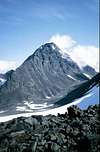|
|
Mountain/Rock |
|---|---|
|
|
67.93560°N / 18.54840°E |
|
|
Mountaineering |
|
|
6702 ft / 2043 m |
|
|
Overview
Kaskasapakte is one of few Swedish mountains whose trade routes require mountaineering skills. Only the west face provides routes with no technical difficulties, but instead has objective danger in the form of rock fall.The most frequented and highly regarded routes are the SW ridge and the E ridge. The SE ridge is also a fairly well traveled route.
The north face provides 500 m of vertical rock and ice straight to the top.
Getting There
The easiest way to get to Kaskasapakte, and other climbing objectives around Tarfala, is through Nikkaluokta, 60 km west of Kiruna.Kiruna is accessible by train from Narvik (in Norway) and Stockholm, or by plane from Stockholm and Luleå.
From Kiruna, the road to Nikkaluokta is served by buses a few times per day during tourist season (roughly june-september and february-april). A one way bus ticket will cost approx. 100 SEK and the ride takes about an hour. Departures from the train station in Kiruna are typically about 30 min after train arrivals, making train + bus a very convenient option. Be aware though that the bus does not run outside tourist season (check www.ltnbd.se bus 92 Kiruna-Nikkaluokta for details).
You can also drive your own car to Nikkaluokta.
After Nikkaluokta, there's 23 km of hiking/skiing along an obvious trail to the hut in Tarfala.
There are a few options for shortening the hike.
Summer:
-Boat over Laddjujavri. Cuts out 5 km of hiking, costs about 160 SEK one way.
-Helicopter from Nikkaluokta to Kebnekaise Fjällstation. Cuts out 14 km, costs about 800 SEK one way and saves significant amounts of time.
Winter:
-Snowmobile from Nikkaluokta to Kebnekaise Fjällstation, 270 SEK one way.
Boat and snowmobile transports are run by the Sarri family ( www.nikkaluokta.com ), and the helicopter is run by Kallaxflyg ( www.kallaxflyg.se ).
Red Tape
No fees or permits, but do not put your tent up too close to Kebnekaise Fjällstation, the Tarfala hut or the research station.When To Climb
Kaskasapakte is good for both summer and winter climbing. Summer season is typically june-september, and winter season february-april.The first lasting snow will typically fall in late september or october at altitude, and increasing snow cover, but still insufficient for skis, complicates travel during october and november. As the snow cover becomes sufficient for skis during november, daylight is fading fast, with polar night between 10 december and 1 january, which makes late fall and early winter a difficult season.
By the end of december, skis are a viable option for travel, but the cold (15 to 30 degrees C below freezing during the day) and lack of daylight still deter most climbers and ski tourers.
As january ends and february begins, temperatures are climbing and the snow cover remains good, ushering in the winter tourist season. Night time temperatures of -30 or colder are still quite possible.
April typically marks the end of viable ski travel in lower terrain, and in may and early june there's too little snow for skis, but too much water from the melting snow for walking.
As the ground dries up in early june, summer season begins, bringing daytime temperatures anywhere between 5 and 20 degrees C, and nighttime temperatures that can approach freezing even in the middle of summer. Midnight sun lasts from 10 june to 1 july, and daylight is abundant from mid may to mid august, enabling climbing during all 24 hours of the day.
During this time, mosquitoes can be a problem at lower altitude, but they tend to be blown away in open landscapes. As fall arrives in late august, mosquitoes die off and become less of an issue.
Camping
The Tarfala hut serves as a good base camp, with bunk beds and a kitchen availible for a fee during tourist season. Tent camping is possible nearby, but avoid pitching your tent right next to the hut. There are also possible tent camping spots further south close to the research station ("Forskningsstation" on the map), but the same applies here; do not pitch your tent too close to the buildings.If you're ascending and descending the SW ridge (or other routes starting from that area), it is possible to find descent tent spots near Gaskassjavri.






